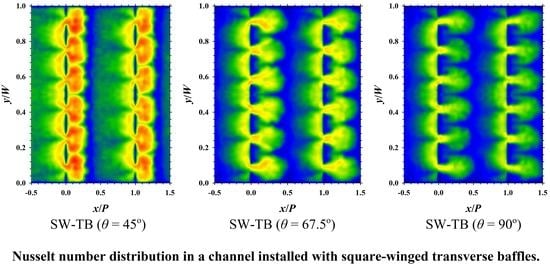Thermal Visualization and Performance Analysis in a Channel Installing Transverse Baffles with Square Wings
Abstract
:1. Introduction
2. Channel and Perforated Square-Wing Transverse Baffle Configurations
3. Experimental Program
4. Data Assessment
5. Experimental Validation
6. Experimental Results and Discussion
6.1. Local Nusselt Number Characteristics
6.2. Average Heat Transfer Rate
6.3. Friction Factor
6.4. Thermal Performance Evaluation
6.5. Comparison with the Relevant Works
6.6. Empirical Correlation of Heat Transfer (Nu) and Friction Factor (f) and TPF
7. Conclusions
- ◦
- The SW-TBs where θ = 0°, 22.5°, 45°, 67.5°, and 90°, respectively, showed augmented heat transfer of 69.6–152.9%, 85.37–183.4%, 83.05–179.9%, 61.9–143.3%, and 50.2–124.3% over that of a smooth channel. The enhanced heat transfer corresponded to TPF values of 0.76–1.09, 0.85–1.25, 0.86–1.26, 0.77–1.11, and 0.72–1.03, respectively.
- ◦
- Square-winged transverse baffles (SW-TBs) have a practical design for decreasing the pressure drop penalty. They are useful in designing baffles that promote energy savings.
- ◦
- Square-winged transverse baffles (SW-TBs) promoted recirculation flow and induced multiple impinging flows behind each baffle. This allowed better contact between the fluid flow and the channel wall, and thus more efficient heat transfer.
Author Contributions
Funding
Conflicts of Interest
Nomenclature
| a | square perforated height, (m) |
| A | heat transfer area |
| Ain | cross-sectional channel area of the flow entrance |
| b | square perforated width, (m) |
| c | distance between the square perforated, (m) |
| cp | specific heat of air at constant pressure, (J/kg K) |
| Dh | hydraulic diameter, (m) |
| f | friction factor of channel with baffles, (-) |
| fs | friction factor of smooth channel, (-) |
| h | baffle height, (m) |
| H | channel height, (m) |
| h | coefficient of heat transfer, (W/m2 K) |
| I | current, (amp) |
| kf | thermal conductivity of air, (W/m K) |
| L | air flow passage length, (m) |
| air mass flow rate, (kg/s) | |
| Nu | Nusselt number of channels with baffles, (-) |
| Nus | Nusselt number of smooth channels, (-) |
| p | transverse baffle pitch length, (m) |
| P | static pressure, (Pa) |
| ΔP | pressure drop, (Pa) |
| Qa | heat gain of air, (W) |
| Qconv | heat convection, (W) |
| Re | Reynolds number, (-) |
| t | baffle thickness, (m) |
| Tb | bulk temperature of air, (K) |
| Ti | inlet temperature of air, (K) |
| To | outlet temperature of air, (K) |
| Tw | wall temperature of heater plate, (K) |
| u | air inlet velocity, (m/s) |
| V | voltage, (volts) |
| volumetric flow rate, (m3/s) | |
| W | channel width, (m) |
| Greek symbols | |
| θ | attack angle of square wing (degrees) |
| μ | viscosity of air, (Ns/m2) |
| β | opening area ratio |
| ρ | density of air, (kg/m3) |
| Subscripts | |
| a | air |
| b | bulk |
| con | convective |
| f | fluid |
| h | hydraulic |
| i | inlet |
| o | outlet |
| w | wall |
| Abbreviations | |
| PB | perforated baffle |
| PLA | polylactic acid |
| RTD | resistance temperature detectors |
| SW-TB | square-winged transverse baffle |
| TLC | thermochromic liquid crystals |
| TPF | thermal performance factor |
References
- Alqarni, M.S.; Memon, A.A.; Anwaar, H.; Usman; Muhammad, T. The forced convection analysis of water alumina nanofluid flow through a 3D annulus with rotating cylinders via κ-ε turbulence model. Energies 2022, 15, 6730. [Google Scholar] [CrossRef]
- Khatri, R.; Goswami, S.; Anas, M.; Sharma, S.; Agarwal, S.; Aggarwal, S. Performance evaluation of an arched plate solar air heater with porous aluminum wire mesh cylindrical fins. Energy Rep. 2020, 6, 627–633. [Google Scholar] [CrossRef]
- Kumar, A.; Kim, M.H. Heat transfer and fluid flow characteristics in air duct with various V-pattern rib roughness on the heated plate: A comparative study. Energy 2016, 103, 75–85. [Google Scholar] [CrossRef]
- Promvonge, P.; Eiamsa-ard, S.; Wongcharee, K.; Chuwattanakul, V.; Samruaisin, P.; Chokphoemphun, S.; Nanan, K.; Eiamsa-ard, P. Characterization of heat transfer and artificial neural networks prediction on overall performance index of a channel installed with arc-shaped baffle turbulators. Case Stud. Therm. Eng. 2021, 26, 101067. [Google Scholar] [CrossRef]
- Kumar, R.; Sethi, M.; Chauhan, R.; Kumar, A. Experimental study of enhancement of heat transfer and pressure drop in a solar air channel with discretized broken V-pattern baffle. Renew. Energy 2017, 101, 856–872. [Google Scholar] [CrossRef]
- Feng, C.N.; Liang, C.H.; Li, Z.X. Friction factor and heat transfer evaluation of cross-corrugated triangular flow channels with trapezoidal baffles. Energy Build. 2022, 257, 111816. [Google Scholar] [CrossRef]
- Karwa, R.; Maheshwari, B.K. Heat transfer and friction in an asymmetrically heated rectangular duct with half and fully perforated baffles at different pitches. Int. Commun. Heat Mass Transf. 2009, 36, 264–268. [Google Scholar] [CrossRef]
- Ary, B.K.P.; Lee, M.S.; Ahn, S.W.; Lee, D.H. The effect of the inclined perforated baffle on heat transfer and flow patterns in the channel. Int. Commun. Heat Mass Transf. 2012, 39, 1578–1583. [Google Scholar] [CrossRef]
- Sriromreun, P.; Thianpong, C.; Promvonge, P. Experimental and numerical study on heat transfer enhancement in a channel with Z-shaped baffles. Int. Commun. Heat Mass Transf. 2012, 39, 945–952. [Google Scholar] [CrossRef]
- Kumar, R.; Nadda, R.; Kumar, S.; Razak, A.; Sharifpure, M.; Aybar, H.S.; Saleel, C.A.; Afzal, A. Influence of artificial roughness parametric variation on thermal performance of solar thermal collector: An experimental study, response surface analysis and ANN modelling. Sustain. Energy Technol. Assess. 2022, 52, 102047. [Google Scholar] [CrossRef]
- El Habet, M.A.; Ahmed, S.A.; Saleh, M.A. Thermal/hydraulic characteristics of a rectangular channel with inline/staggered perforated baffles. Int. Commun. Heat Mass Transf. 2021, 128, 105591. [Google Scholar] [CrossRef]
- Boonloi, A.; Jedsadaratanachai, W. CFD analysis on heat transfer characteristics and fluid flow structure in a square duct with modified wavy baffles. Case Stud. Therm. Eng. 2022, 29, 101660. [Google Scholar] [CrossRef]
- Bhattacharyya, S.; Vishwakarma, D.K.; Goel, V.; Chamoli, S.; Issakhov, A.; Meyer, J.P. Thermodynamics and heat transfer study of a circular tube embedded with novel perforated angular-cut alternate segmental baffles. J. Therm. Anal. Calorim. 2021, 145, 1445–1465. [Google Scholar] [CrossRef]
- Faujdar, S.; Agrawal, M. Computational fluid dynamics based numerical study to determine the performance of triangular solar air heater duct having perforated baffles in V-down pattern mounted underneath absorber plate. Sol Energy 2021, 52, 235–252. [Google Scholar] [CrossRef]
- Tandel, H.U.; Modi, K.V. Experimental assessment of double-pass solar air heater by incorporating perforated baffles and solar water heating system. Renew. Energy 2022, 183, 385–405. [Google Scholar] [CrossRef]
- Khanlari, A.; Tuncer, A.D.; Sözen, A.; Aytaç, İ.; Çiftçi, E.; Variyenli, H.İ. Energy and exergy analysis of a vertical solar air heater with nano-enhanced absorber coating and perforated baffles. Renew. Energy 2022, 187, 586–602. [Google Scholar] [CrossRef]
- El Habet, M.A.; Ahmed, S.A.; Saleh, M.A. The effect of using staggered and partially tilted perforated baffles on heat transfer and flow characteristics in a rectangular channel. Int. J. Therm. Sci. 2022, 174, 107422. [Google Scholar] [CrossRef]
- Webb, R.L. Performance evaluation criteria for use of enhanced heat transfer surfaces in heat exchanger design. Int. J. Heat Mass Transf. 1981, 24, 715–726. [Google Scholar] [CrossRef]
- Nanan, K.; Thianpong, C.; Pimsarn, M.; Chuwattanakul, V.; Eiamsa-ard, S. Flow and thermal mechanisms in a heat exchanger tube inserted with twisted cross-baffle turbulators. Appl. Therm. Eng. 2017, 114, 130–1475. [Google Scholar] [CrossRef]
- Kline, S.J.; McClintock, F.A. Describing Uncertainties in Single Sample Experiments. Mech. Eng. 1953, 75, 3–8. [Google Scholar]
- Bergman, T.L.; Lavine, A.S.; Incropera, F.P.; Dewitt, P.D. Fundamentals of Heat and Mass Transfer, 7th ed.; John Wiley & Sons Inc.: Hoboken, NJ, USA, 2011. [Google Scholar]
- Chamoli, S.; Thakur, N.S. Correlations for solar air heater duct with V-shaped perforated baffles as roughness elements on absorber plate. Int. J. Sustain. Energy 2016, 35, 1–20. [Google Scholar] [CrossRef]


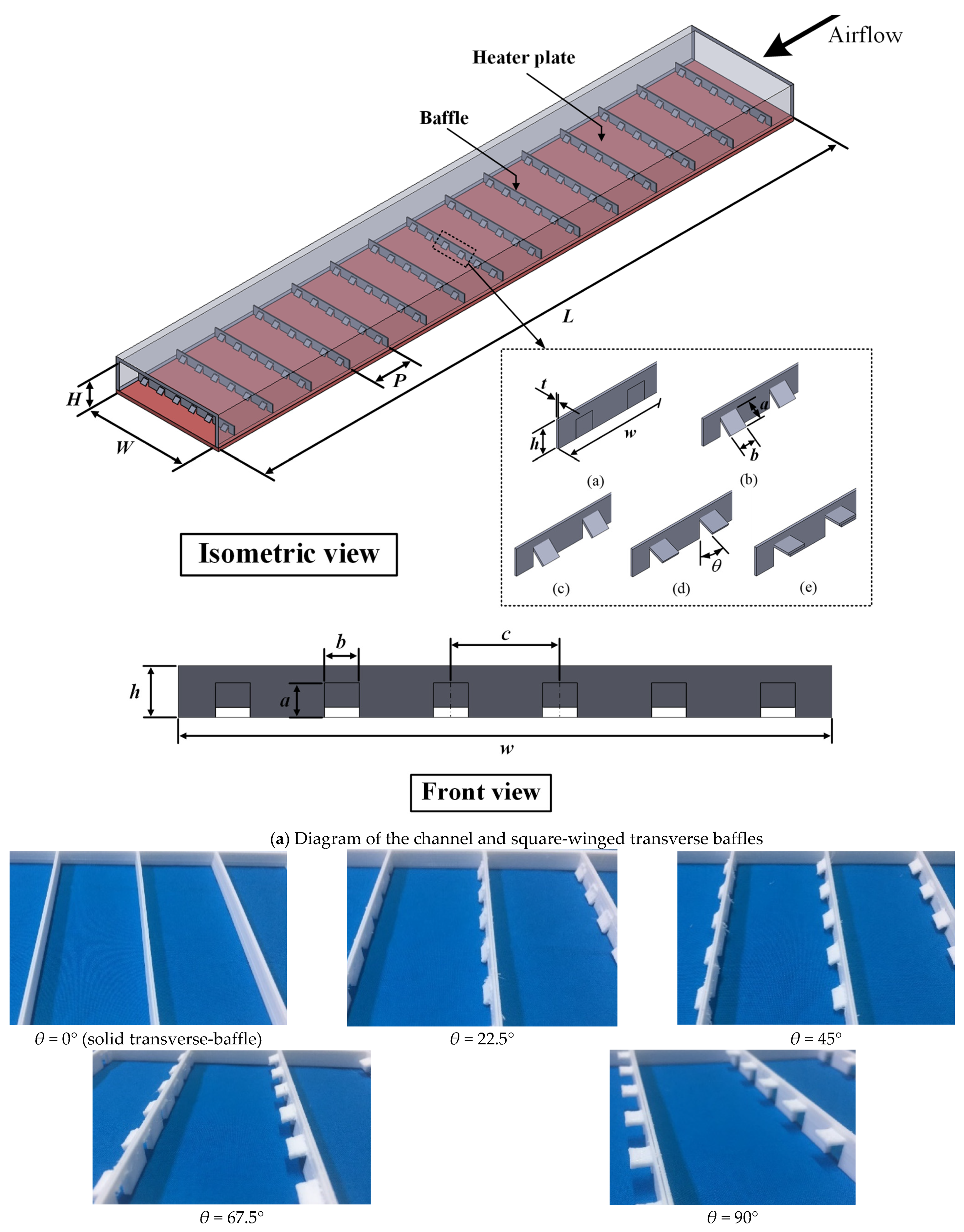

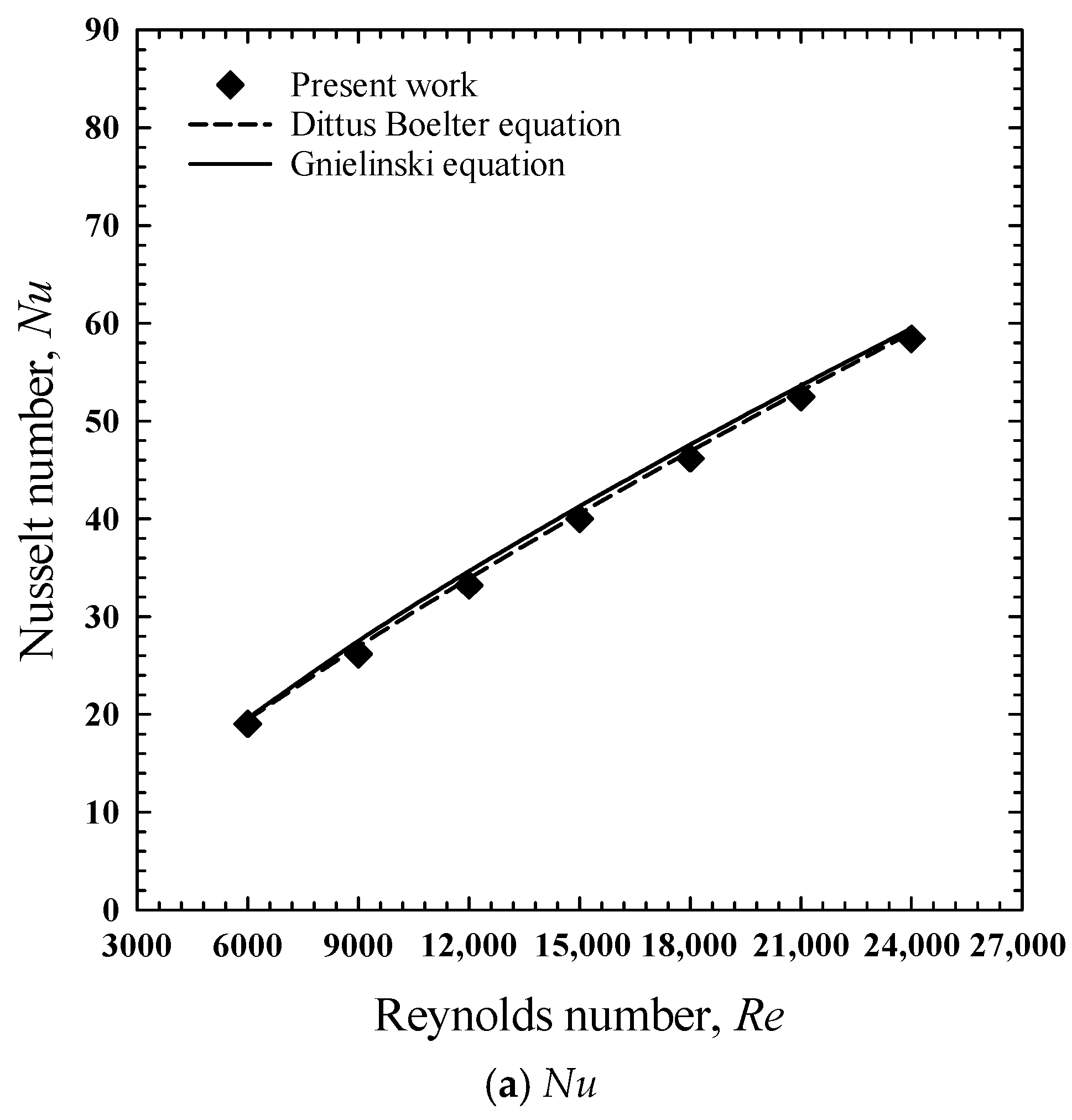
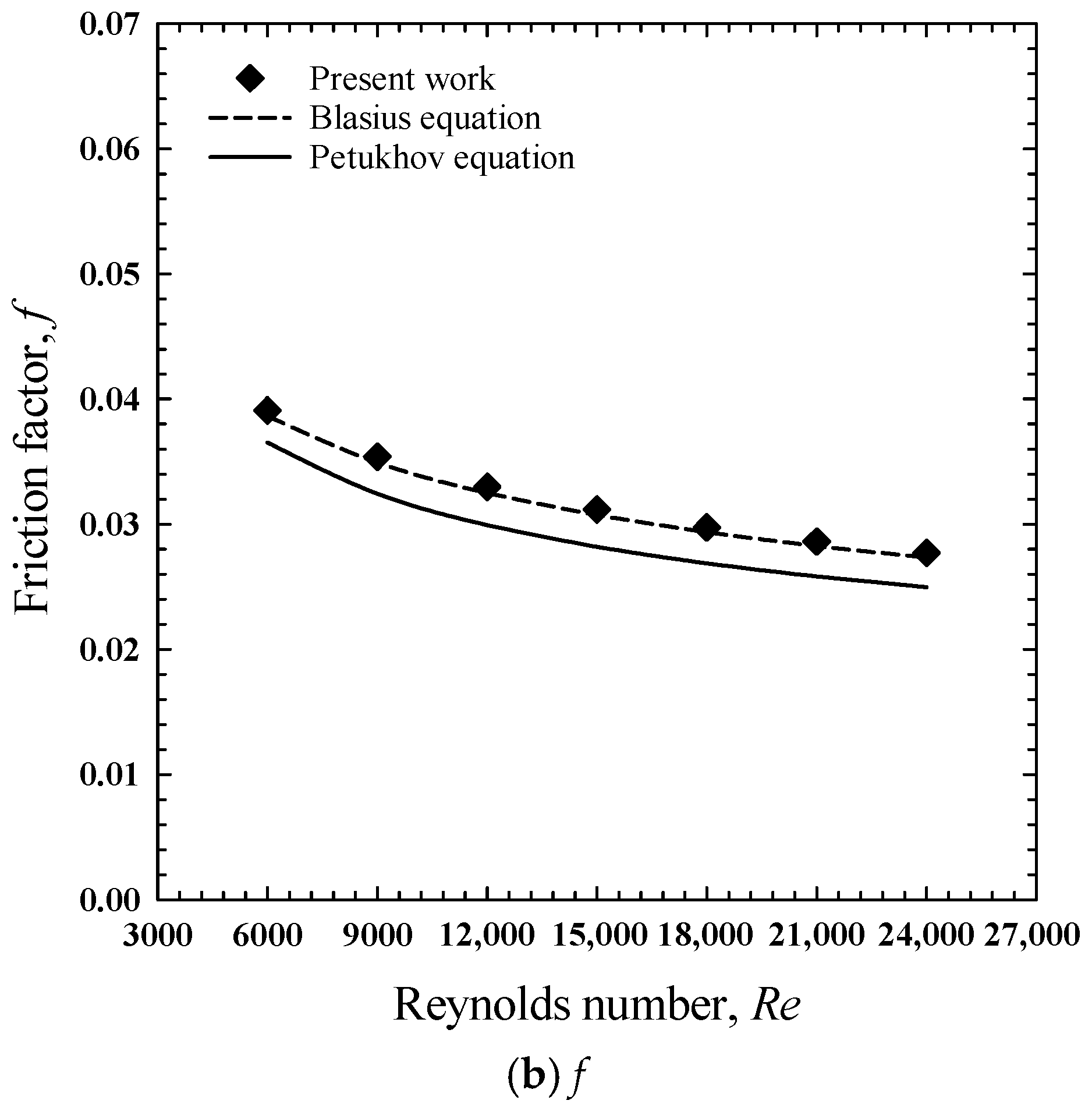
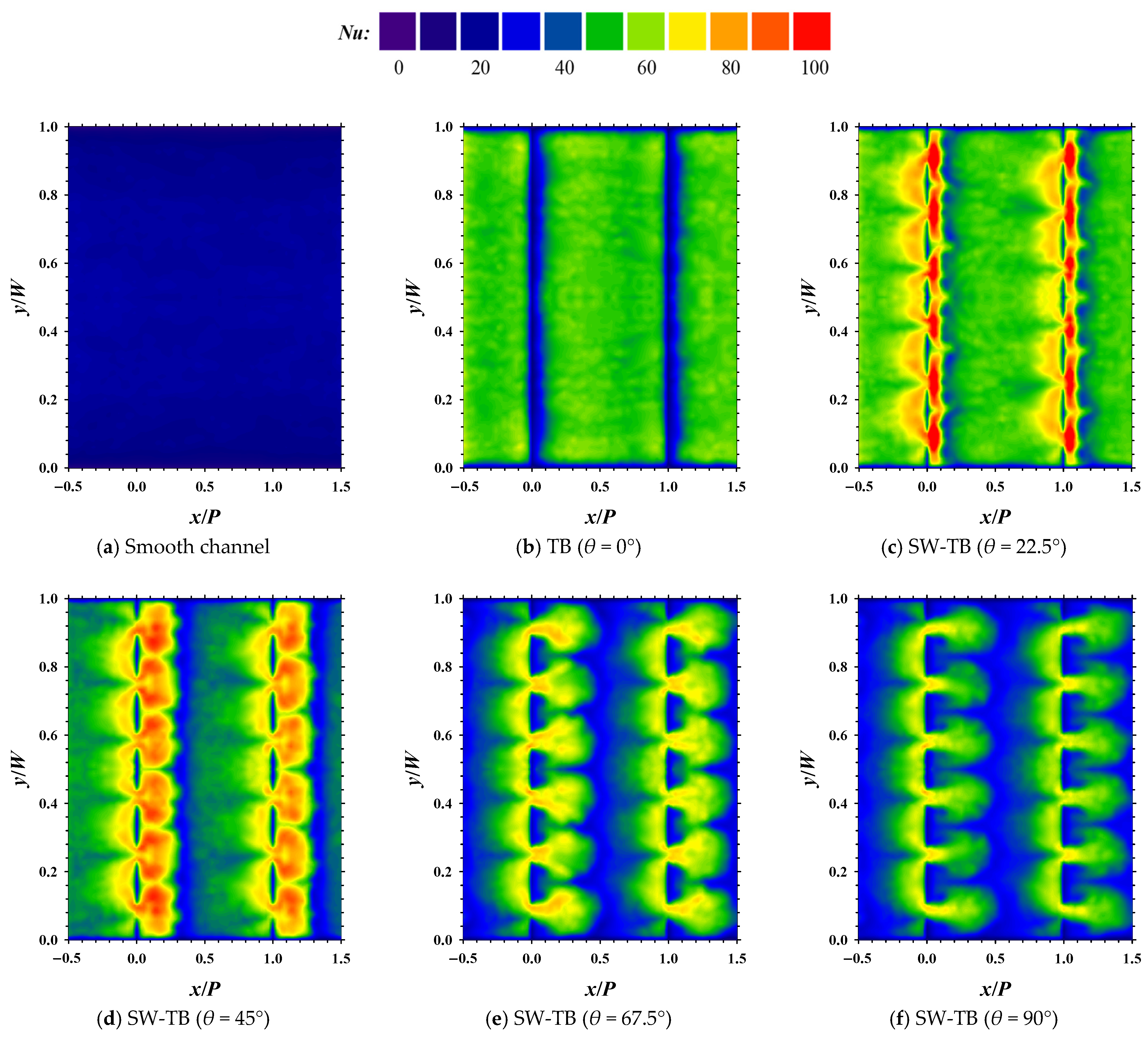
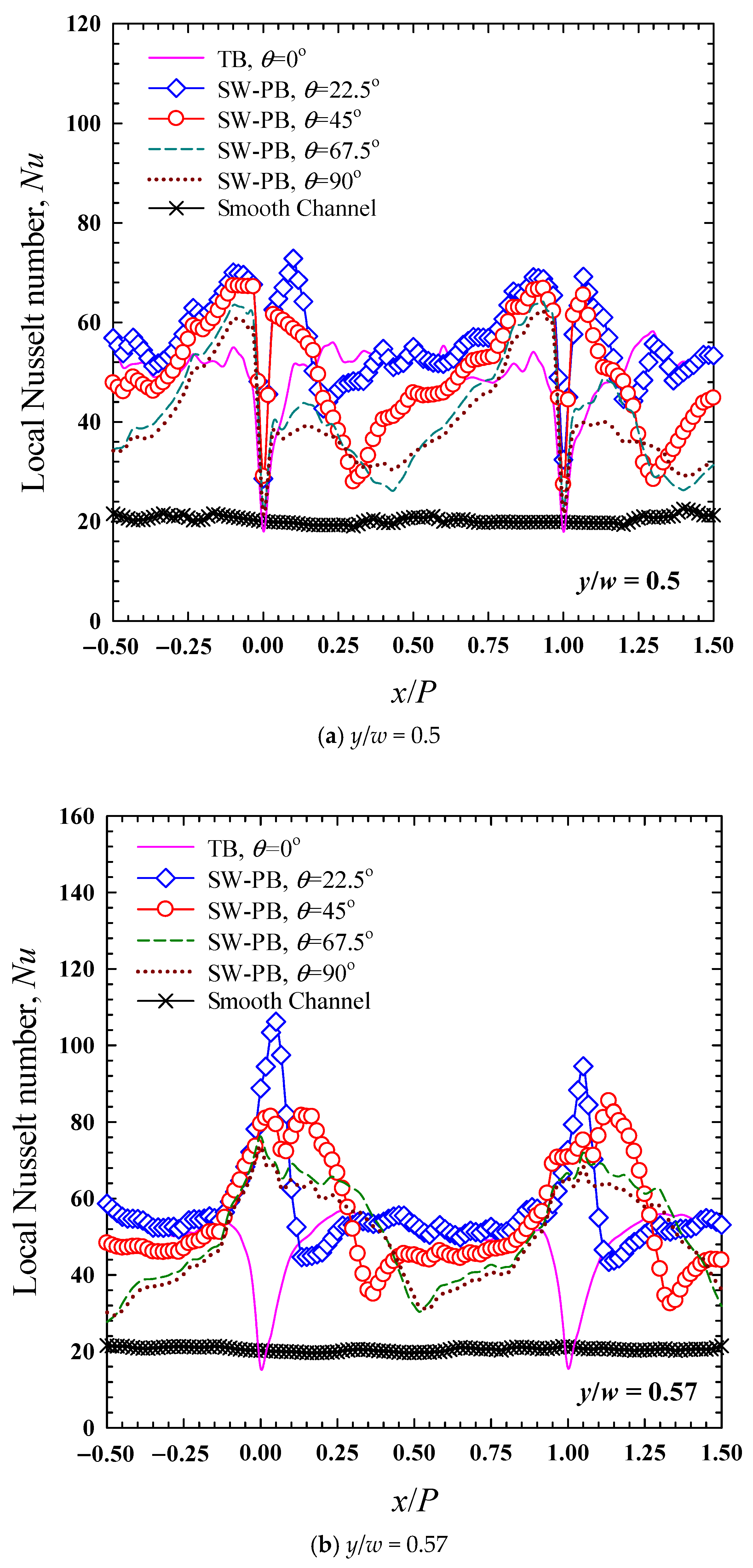
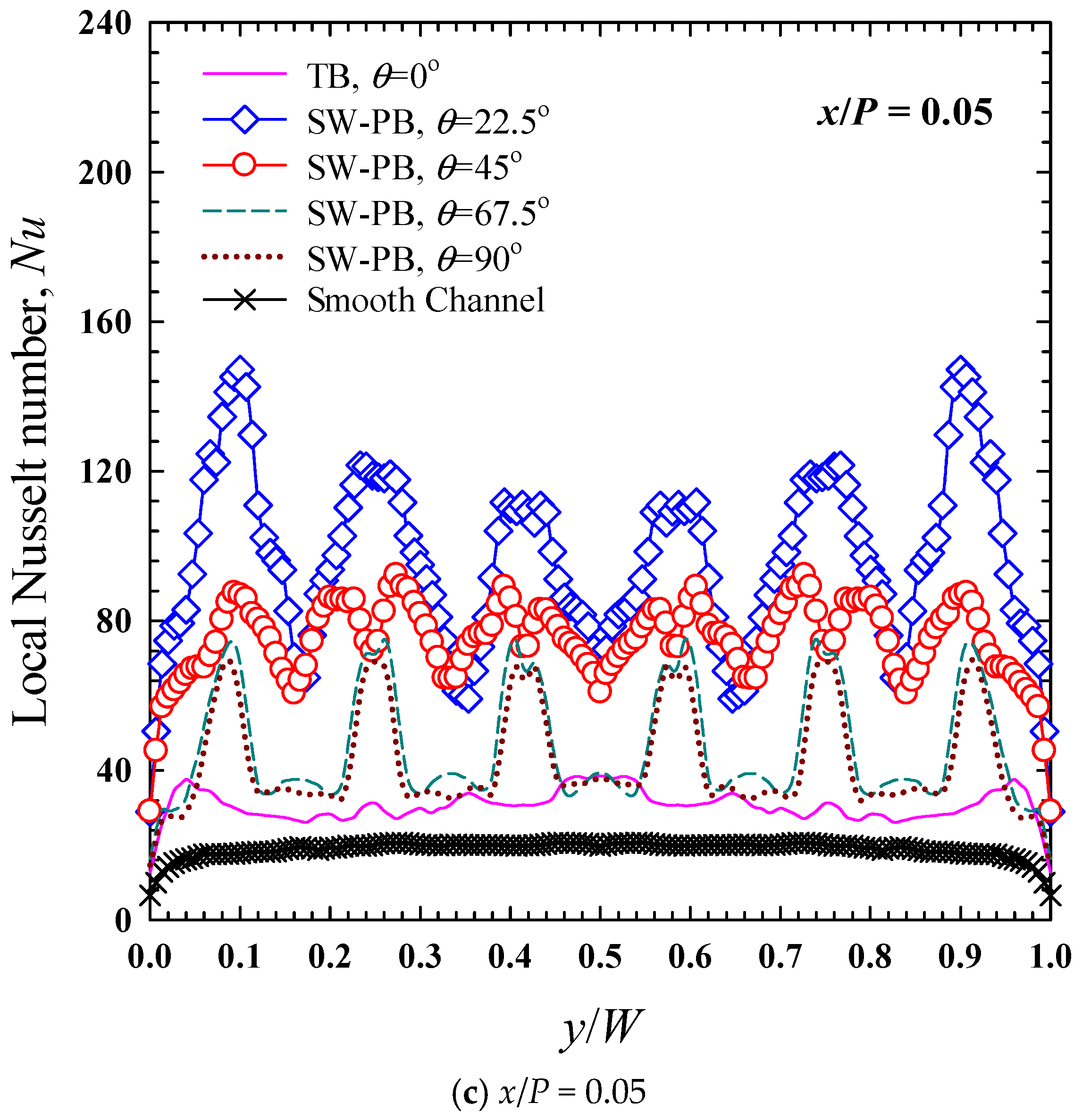
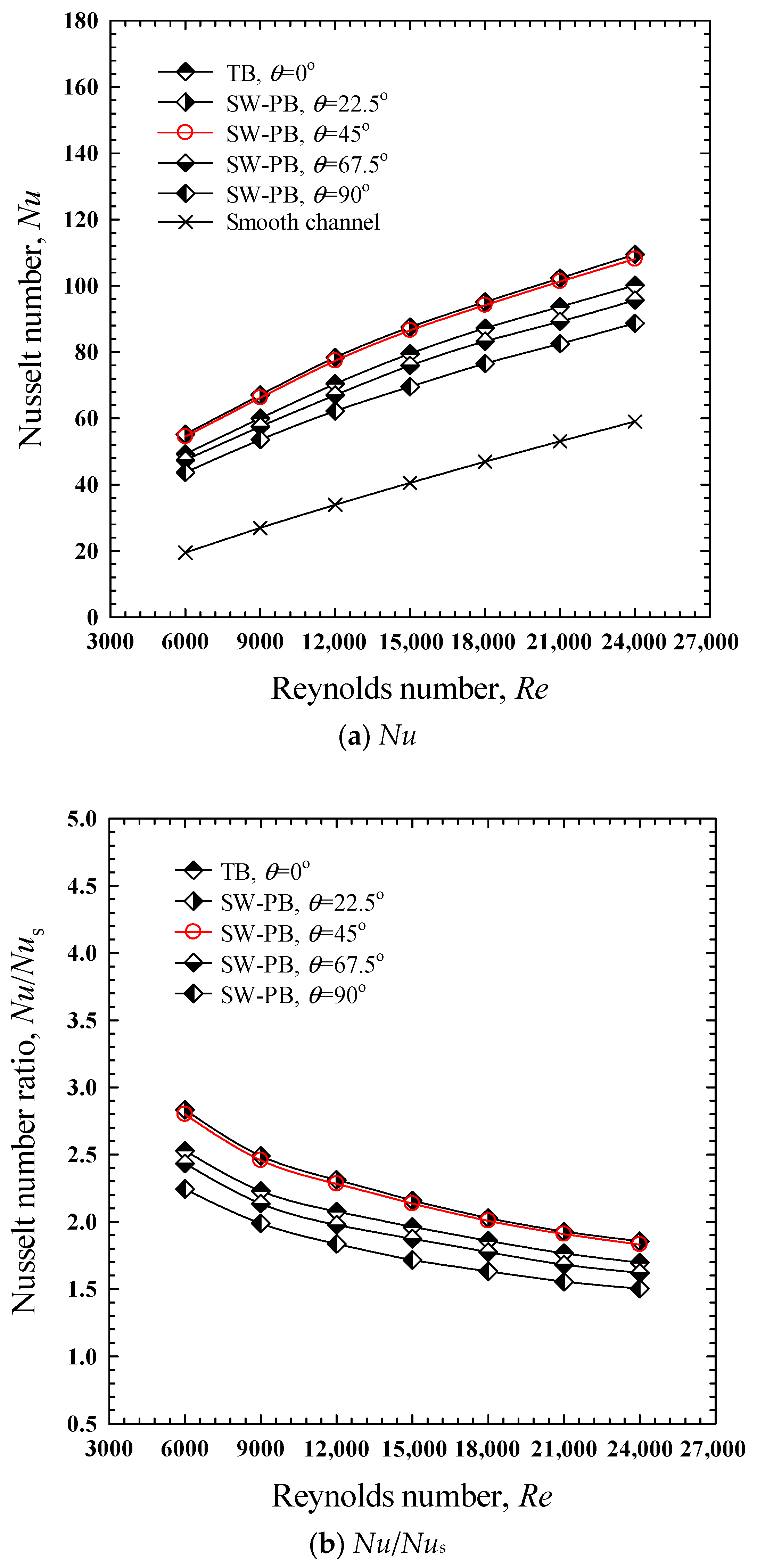
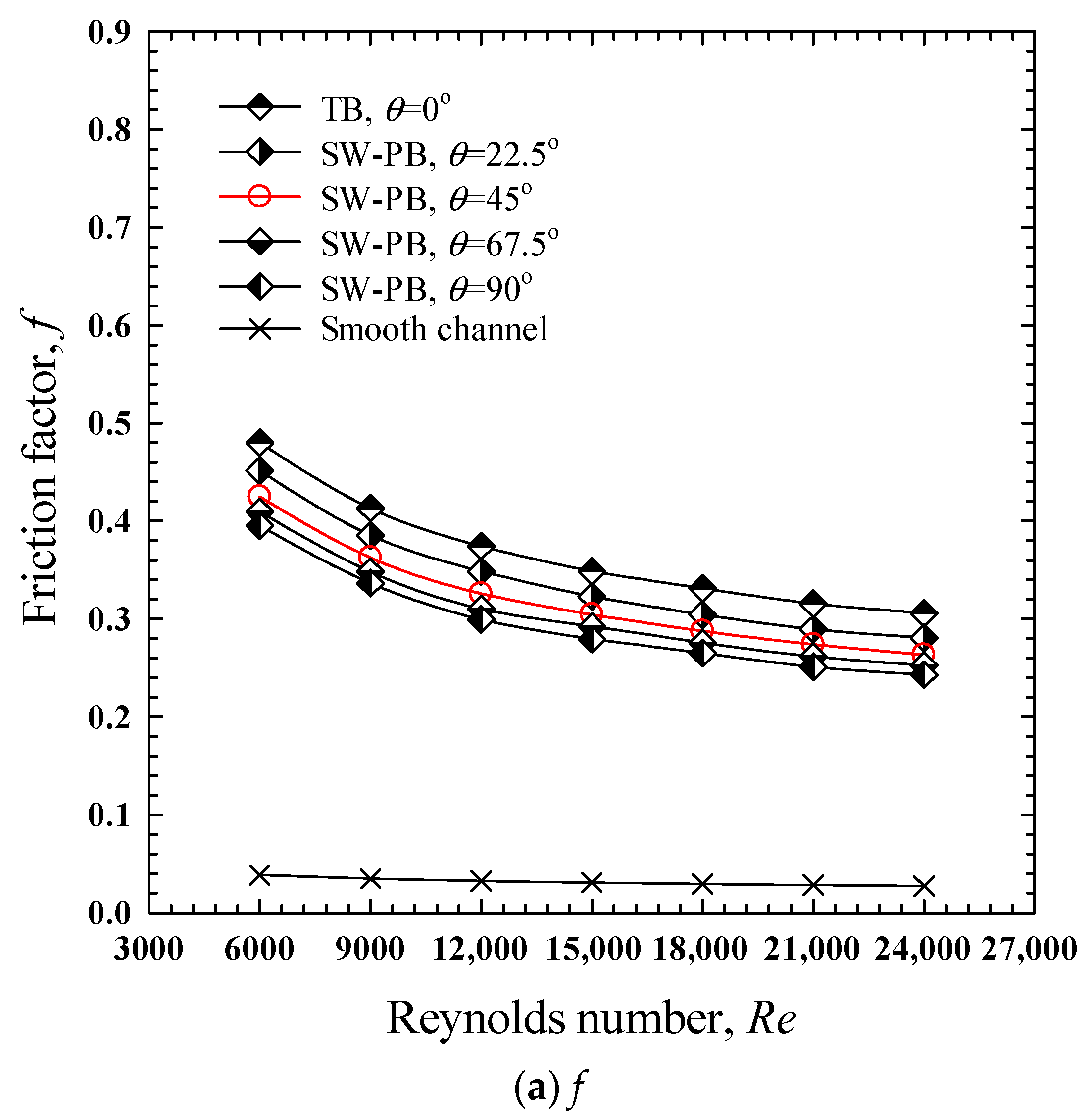
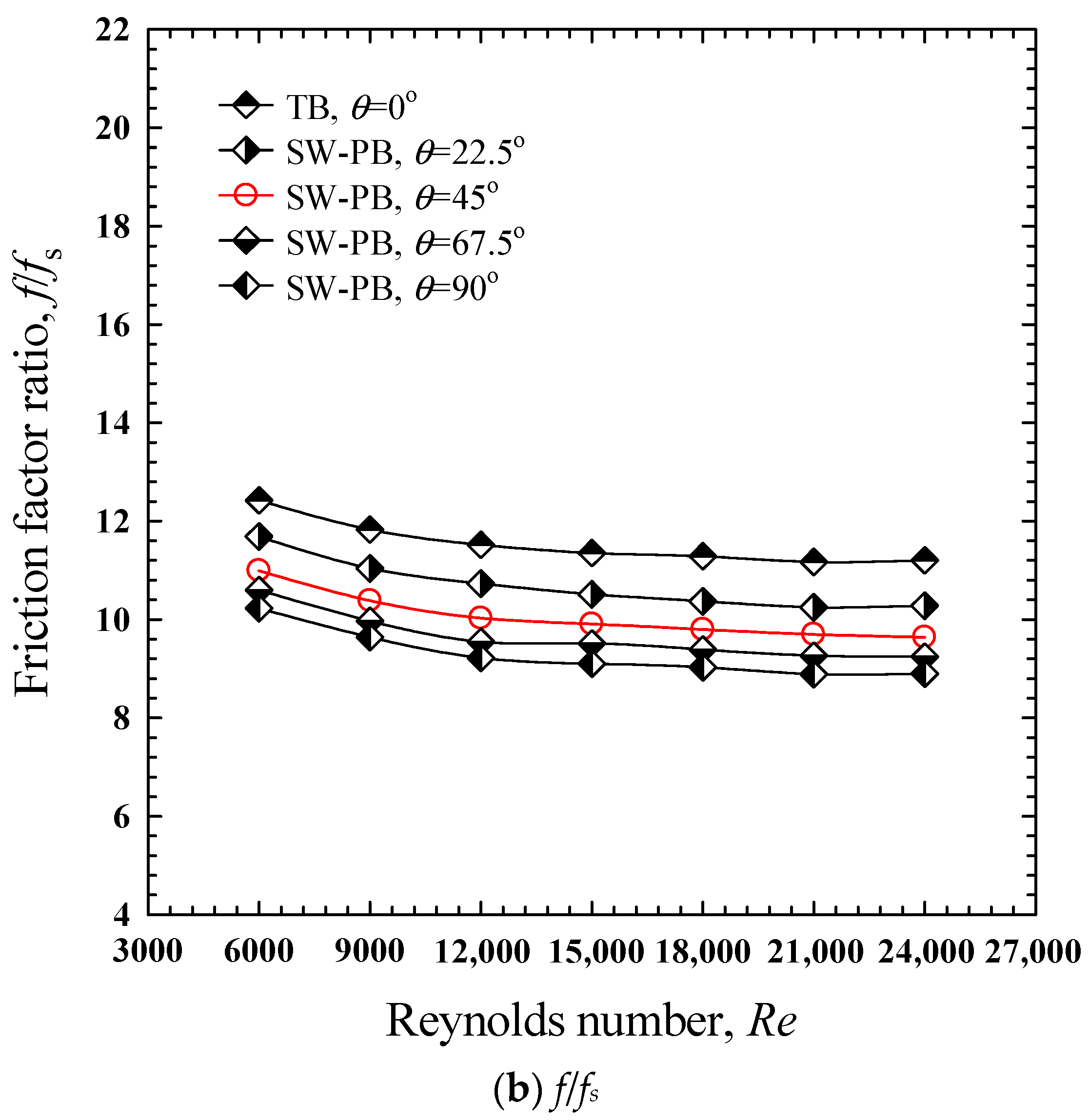

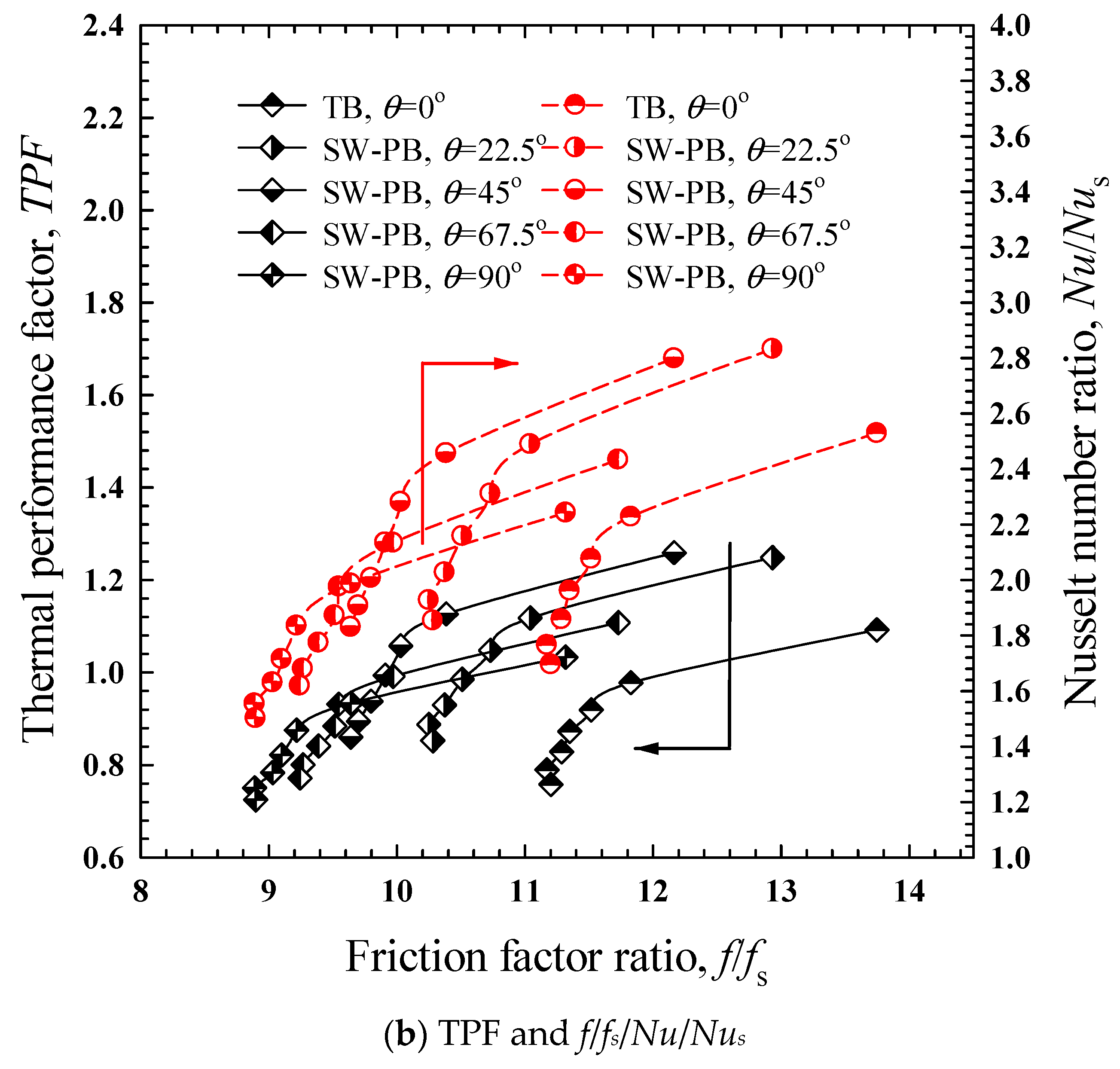

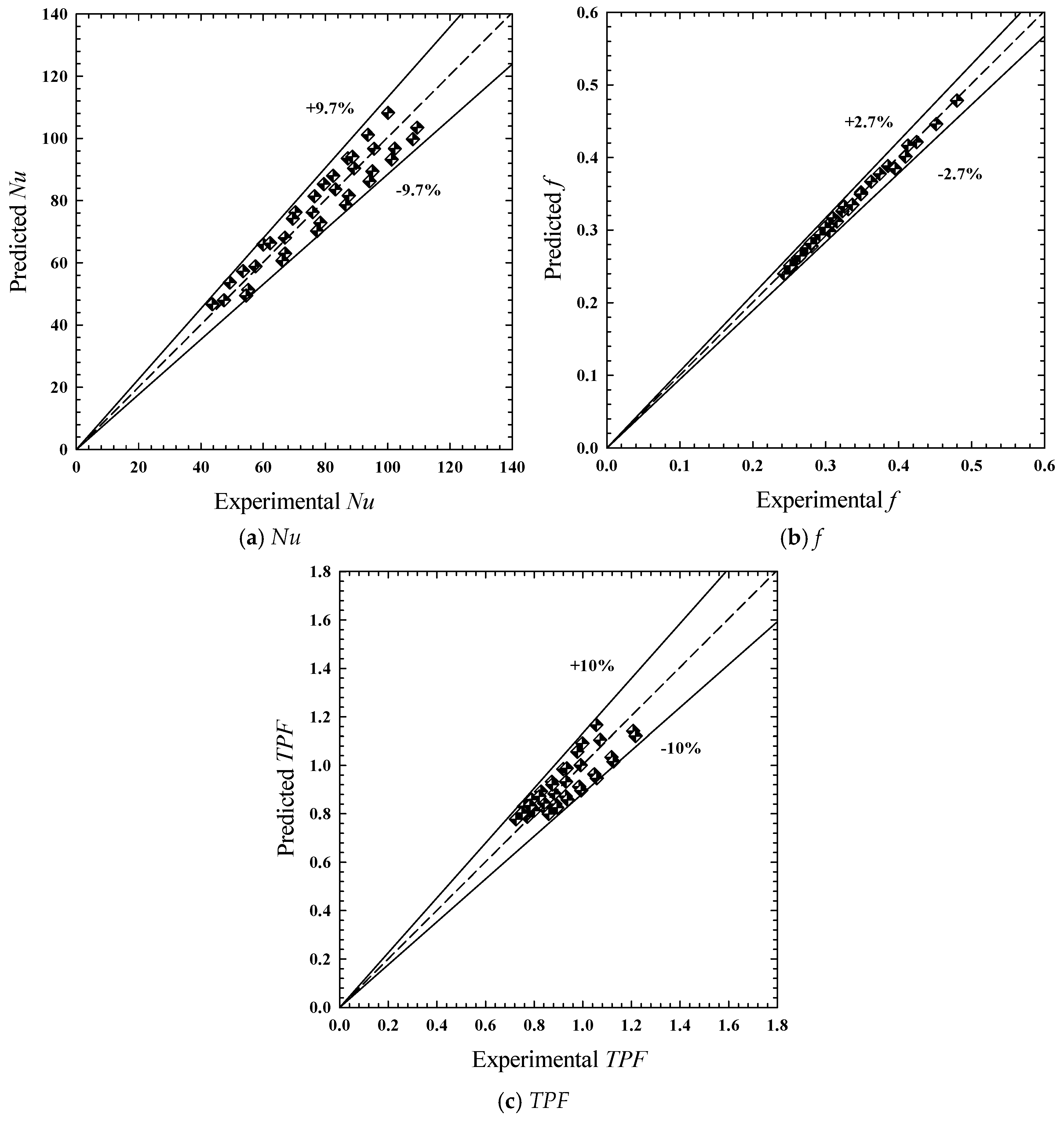
| No. | Parameter | Value |
|---|---|---|
| 1 | Blockage ratio (h/H) | 0.2 |
| 2 | Pitch ratio (p/H) | 1.5 |
| 3 | Square-wing attack angles (θ) | 0°, 22.5°, 45°, 67.5°, and 90° |
| 4 | Area ratio of the perforation holes | 0.21 |
| 5 | Aspect ratio (W:H) | 3.75 |
| 6 | Reynolds number (Re) | 6000–24,000 |
| 7 | Heat flux condition | 600 W/m2 |
| Experimental Parameter | Units | (%) Maximum Uncertainties |
|---|---|---|
| Nu | - | 5.12 |
| f | - | 4.98 |
| Re | - | 4.6 |
| TPF | - | 5.2 |
Publisher’s Note: MDPI stays neutral with regard to jurisdictional claims in published maps and institutional affiliations. |
© 2022 by the authors. Licensee MDPI, Basel, Switzerland. This article is an open access article distributed under the terms and conditions of the Creative Commons Attribution (CC BY) license (https://creativecommons.org/licenses/by/4.0/).
Share and Cite
Eiamsa-Ard, S.; Phila, A.; Wongcharee, K.; Chuwattanakul, V.; Pimsarn, M.; Maruyama, N.; Hirota, M. Thermal Visualization and Performance Analysis in a Channel Installing Transverse Baffles with Square Wings. Energies 2022, 15, 8736. https://doi.org/10.3390/en15228736
Eiamsa-Ard S, Phila A, Wongcharee K, Chuwattanakul V, Pimsarn M, Maruyama N, Hirota M. Thermal Visualization and Performance Analysis in a Channel Installing Transverse Baffles with Square Wings. Energies. 2022; 15(22):8736. https://doi.org/10.3390/en15228736
Chicago/Turabian StyleEiamsa-Ard, Smith, Arnut Phila, Khwanchit Wongcharee, Varesa Chuwattanakul, Monsak Pimsarn, Naoki Maruyama, and Masafumi Hirota. 2022. "Thermal Visualization and Performance Analysis in a Channel Installing Transverse Baffles with Square Wings" Energies 15, no. 22: 8736. https://doi.org/10.3390/en15228736
APA StyleEiamsa-Ard, S., Phila, A., Wongcharee, K., Chuwattanakul, V., Pimsarn, M., Maruyama, N., & Hirota, M. (2022). Thermal Visualization and Performance Analysis in a Channel Installing Transverse Baffles with Square Wings. Energies, 15(22), 8736. https://doi.org/10.3390/en15228736








